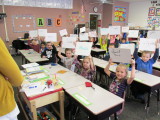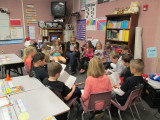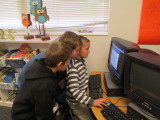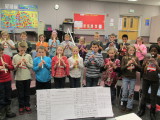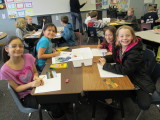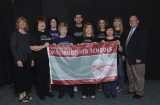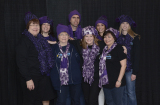-
Category 1
Selected in 2013
-
Grades: pre k - 5
School Setting: urban
Town Population: 5,897
Student Enrollment: 394
Student Demographics:
Black/African American: 1%
Teacher/Student Ratio: 1:25
White/Caucasian: 85.5%
Hispanic: 11%
Hawaiian/Pacific Islander: 1%
Asian: 1%
Native American: 0.5%
Other: 0%
% Reduced Lunch: 46%
% ELL Learners: 9%
Founded: 1999 -
PRINCIPAL:
Jeanette Christenson -
CONTACT:
2545 South 660 West
Nibley, UT 84321
435-752-8525
jeanette.christenson@ccsdut.org
Nibley Elementary
Nibley, UT
With explicit instruction ninety-five percent of students are above grade level. As success builds, student confidence builds, and students are excited to learn thus becoming life-long learners.
- Describe specific programs in place to ensure that families are involved in the success of your school and students.
- Parents sign a school compact which describes expectations and their signature indicates support for our programs. Frequent communication happens with parents. Parent/teacher conferences are held to discuss student needs with every parent Several evenings at school are planned to involve parents in student learning: Back to School Night, Literacy Night, Science Fair Night, and a Reading celebration at the end of the year. In addition to evening activities many events happen during the school day. A fabulous Veteran’s Day Assembly is held with over 35 veterans from various wars being honored by the students. In conjunction with Nibley City, Nibley Elementary School participates in a Scarecrow Festival that focuses on a reading contest between the three elementary schools in Nibley, Utah. Students are encouraged for one week to read as many minutes per night as possible. During the course of the week, Nibley Elementary students read over 20,000 minutes.
- Describe the most successful activity your school has initiated to strengthen ties to your community.
- Each year our school participates in the “One District, One Book” program where the entire school including families read the same book. Information is sent home and an assembly kicks off the event. This year we will read “The Mouse and the Motorcycle”. A guest mouse riding a motorcycle will ride into the gym to introduce the book. The guest mouse will tell a story from the book to the children and then books will be sent home for each family. This reading culminates in our Literacy Night which is held the end of February to celebrate reading. The students and their families join together on this evening to celebrate the book that they have read. Authors are present to share their love of writing with the families, games are played with vocabulary from the book, crafts are made that tie directly into the story, and presentations are done that represents a section of the book. Over eighty-five percent of our parents attend.
- Describe your philosophy of school change or improvement.
- It all boils down to respect! Respect for teachers, students and their parents, paraprofessionals and support staff and that the respect is reciprocal with the administration. It requires an administrator who is not willing to accept less than a teacher’s best in any given situation. It necessitates an administrator to think outside of the box and be willing to solve difficult issues and really listen to others. It is important to appreciate the talents each individual brings to the table and work to refine and improve areas of weakness. All participants at the school must desire to improve and help make changes that benefit students and then change can occur. At the center must be the utmost concern for the students, their learning and behavior. It is critical that data is used to drive instruction on a daily basis as well as enhance professional development. Explicit positive praise is essential for teachers and students on a daily basis.
- What are your school’s top two goals for the next year?
- As Nibley moves towards meeting the needs for students to be “College and Career Ready” it is critical that each student at Nibley Elementary School receive the very best education possible using all the resources available. Technology and science innovations are critical to meeting this need and will require students, parents, administrators, and teachers willing to accept new challenges that are faced in the Core Standards. This requires thinking outside of the box and often leaving traditional methods of teaching. Nibley strives to meet the goals of the future by integrating technology, developing student’s complex thinking skills, encouraging critical writing skills, and helping students to develop socially understanding the needs of others. This is an exciting time in education and it is Nibley’s goal to help students embrace the excitement of learning.
- What is the single most important factor in the success of your school that others could replicate?
- The intense reading program where all students receive an additional 30 to 60 minutes of reading instruction daily from people who are prepared to teach and willing to meet the individual needs of students regardless of their reading level.
- Describe the program or initiative that has had the greatest positive effect on student achievement, including closing achievement or opportunity gaps, if applicable.
- Teacher professional development is critical to the success of this program. The Utah Tiered Model (Tier 1, Tier 2, Tier 3) is used to instruct students at a variety of levels. All students receive Tier I which includes a basal reading program. Students who are below grade level receive Tier 2 which consists of direct instruction with groups of five or less at their reading level focusing on their individual skills. Tier 3 supports ESL and resource students. Trained in direct instruction programs paraprofessionals either have two years of college or have passed the PRAXIS for Paraprofessionals. Every school has a half-time reading facilitator. Students who read at grade level or above meet with the classroom teacher for enriched reading instruction to expand their knowledge. With explicit instruction ninety-five percent of students are above grade level. As success builds, student confidence builds, and students are excited to learn thus becoming life-long learners.
- Explain how Title I funds are used to support your improvement efforts.
- Title I funds are used for teacher professional development which is centered on the education of children. The funding is used to hire highly qualified paraprofessionals, additional training for paraprofessionals, evening with families to support literacy, and supplies and equipment to support the direct instruction programs used with at- risk students.
- Identify the critical professional development activities you use to improve teaching and student learning.
- Professional Learning Communities were established three years ago and are used to develop a cohesive curriculum, examine data, and fine tune the learning process throughout the school. Teachers have a common preparation time to allow them additional opportunities to work and collaborate together. Training in the use of new technologies happens at Nibley. Each teacher received an I-pad at the beginning of the year along with training to implement the technology into their classroom. Teachers were also asked to videotape themselves during six different teaching sessions and analyze the data regarding their teaching style. Teachers discussed their findings and determined how to implement change. Engagement strategies are modeled and teachers held accountable to practice them on a regular basis with their students. Observations are conducted by the administrator to help the teacher fine tune their craft and work with the teacher on the success of integrating the new strategies.
- Describe how data is used to improve student achievement and inform decision making.
- Data is used in every Professional Learning Community (PLC) Meeting whether it is a large group meeting or grade level meeting. Formative data is used in all subject areas to direct instruction for all students and group students for re-teaching where necessary. Data is also used to place students in groups for reading instruction as well as placement in early morning math tutoring sessions. Summative data is utilized not only to help students but to strengthen professional development. Summative data can demonstrate holes in the curriculum or weaknesses of the instructor. Using the data can prompt appropriate professional development to strengthen weak teaching skills and build confidence in new areas.
- Describe your school culture and explain changes you’ve taken to improve it.
- Previously at Nibley parents felt that the principal was not accessible. All activities are assessable to every student. A warm, inviting feeling envelopes all who enter the doors of Nibley Elementary. At every Professional Learning Community Meeting, students’ needs are discussed and faculty reminded that no one knows the burden a child may be carrying into the school. The culture at Nibley is to not make the child’s burden any greater by what happens at school. The principal and teachers truly care for and love each child. Bulletin boards are bright and friendly, the cafeteria has inviting posters, the library is open before and after school for students to check out books and take reading quizzes. The principal, teachers, and support staff arrive early and welcome students to the school on a daily basis. Parents are invited to all assemblies and programs at the school. Information from school is sent home to all families and translated where needed.
Stats
-
Category 1
Selected in 2013
-
Grades: pre k - 5
School Setting: urban
Town Population: 5,897
Student Enrollment: 394
Student Demographics:
Black/African American: 1%
Teacher/Student Ratio: 1:25
White/Caucasian: 85.5%
Hispanic: 11%
Hawaiian/Pacific Islander: 1%
Asian: 1%
Native American: 0.5%
Other: 0%
% Reduced Lunch: 46%
% ELL Learners: 9%
Founded: 1999 -
PRINCIPAL:
Jeanette Christenson -
CONTACT:
2545 South 660 West
Nibley, UT 84321
435-752-8525
jeanette.christenson@ccsdut.org


